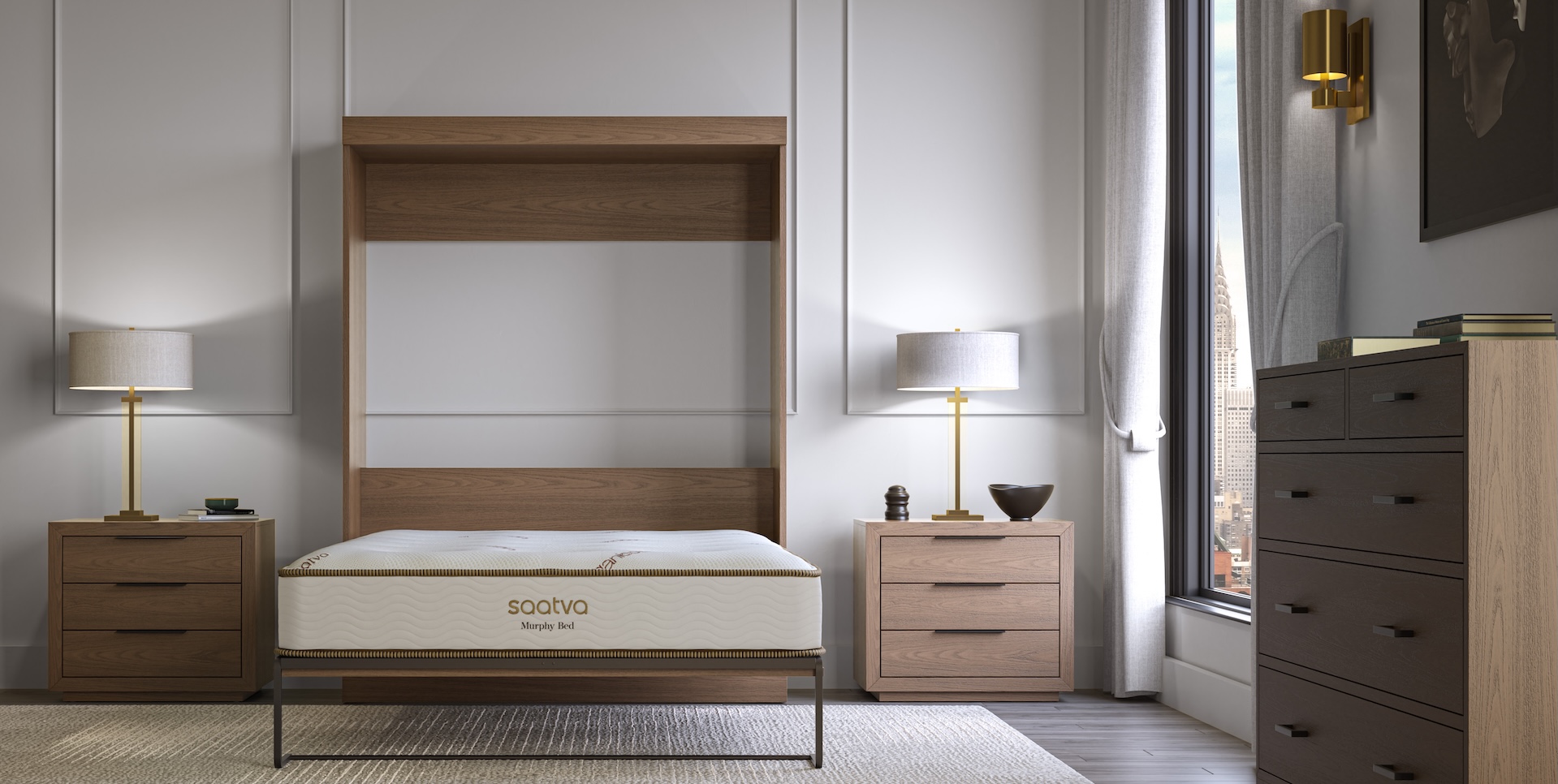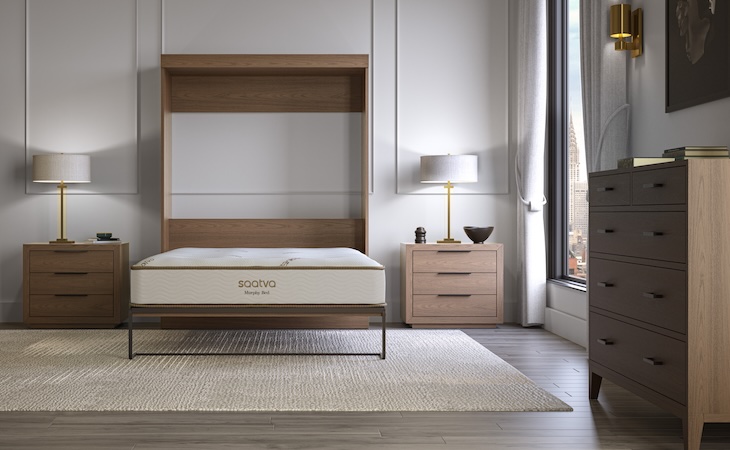A Murphy bed (also referred to as a pull-down bed, fold-down bed, wall bed, or cabinet bed) is a bed that’s hinged to the wall on one end, which makes it possible to fold it up and store it vertically against the wall during the day and pull it down only when needed.
If you live in a small space—whether a studio apartment or a tiny house—a Murphy bed can be a lifesaver. This multifunctional piece of furniture can often be customized to double as a sofa or desk, helping you turn your cozy living quarters into a multipurpose space.
When buying a Murphy bed, it’s important to measure your space correctly. Many people don’t realize that Murphy beds come in a variety of sizes.
A Murphy bed (also referred to as a pull-down bed, fold-down bed, wall bed, or cabinet bed) is a bed that’s hinged to the wall on one end, which makes it possible to fold it up and store it vertically against the wall during the day and pull it down only when needed.
The right size for you will depend on the space you have available and your personal circumstances. Read on to find out how to measure your space correctly and how to choose the ideal Murphy bed size for you.
How to measure your space for a Murphy bed
Before buying a Murphy bed, it’s essential to measure so you can make sure you have enough floor space to keep it open and wall space to keep it folded.
To start, you should know that there are two types of Murphy beds: horizontal and vertical.
Horizontal Murphy beds
Horizontal Murphy beds have their widest side lined up and attached to the wall. These are perfect for rooms with low ceilings that may not have enough clearance to accommodate a vertical Murphy bed. The downside of these is that you can only enter the bed from one side (i.e., the side that’s not attached to the wall).
Vertical Murphy beds
Vertical Murphy beds are the more common type. They’re attached to the wall on their shortest side so that when they’re unfolded they allow you enter the bed from either side. If you want to get a vertical Murphy bed it’s important to make sure you have enough clearance to fold it up.
Instructions for taking measurements
Regardless of whether you’re setting up a horizontal or vertical Murphy bed, follow these steps to ensure you get precise measurements:
- Using a tape measure, start by measuring the width of the wall where you plan to install the wall bed. You’ll generally want to have at least 80 inches of wall space for horizontal Murphy beds and 47 inches for vertical ones.
- Measure the wall from the floor to the ceiling. You don’t have to do it for horizontal beds, since height doesn’t matter there, but it’s critical for vertical wall beds. For these, you typically need to have a minimum ceiling height of 82 inches. Importantly, make sure the bed can be folded up without hitting anything on the ceiling like light fixtures or ceiling fans.
- Measure the floor area where your want your bed to be when it’s open (this is referred to as the bed’s projection length. The exact requirements differ depending on the specific bed size you’re getting (see below), but the absolute minimum you should have to accommodate the smallest (twin-size) horizontal bed is 49.25 inches of floor space. Vertical wall beds need a minimum of 85.25 inches.
- For vertical Murphy beds, you’ll also want to make sure to have 30 to 36 inches of floor space available on each side of the bed to allow you to easily get into bed from either side.
What to consider when choosing a Murphy bed size
The good news is, Murphy beds, like standard bed frames, come in all standard sizes: twin, full, queen, and king.
Once you’ve measured your space, there are additional factors to consider before selecting the idea wall bed size for you, such as what room it’ll be in, what purpose it will serve, and who will be sleeping on it and how often.
Murphy Bed Mattress Sizes Dimensions Twin 38 x 75 in Full 54 x 75 in Queen 60 x 80 in King 76 x 80 in
Twin-size Murphy beds
Twin-size Murphy beds take a twin mattress (38 inches x 75 inches). They’re an ideal option for kids’ rooms, student dorms, or any small that needs a sleeping space—perhaps one that will only be used occasionally.
Full-size Murphy beds
Full-size Murphy beds take a full mattress (54 inches x 75 inches). They’re best for guest rooms and smaller rooms. They’re perfect if you want a bed that can accommodate a couple but don’t have enough space for a queen-size bed.
Queen-size Murphy beds
Queen-size Murphy beds, the most popular option, take a queen mattress (60 inches x 80 inches). They’re suitable for any setting, provided you have the room for it. They’re perfect for couples or individuals who have a multifunctional bedroom but don’t want to compromise on sleeping space.
King-size Murphy beds
You might be surprised, but king-size Murphy beds do exist. They take a king-size mattress (76 inches x 80 inches), offer plenty of space for couple to sleep comfortably, and and are ideal if you have a large enough room.
FAQs
What’s the typical size of a Murphy bed?
Murphy beds, like standard beds, come in all standard bed sizes: twin, full, queen and king, to accommodate any living space and any situation.
Does a regular mattress fit in a Murphy bed?
The main challenge when choosing a mattress for your Murphy bed is that many regular mattresses deteriorate over time because the layers of the mattress shift when they’re stored vertically. You should therefore look for a mattress designed specifically for Murphy beds.
Are there king-size Murphy beds?
Yes, Murphy beds come in all standard bed sizes. King-size Murphy beds are ideal options couples that live in a multifunctional space that’s large enough to accommodate a luxurious king-size bed.
Find the best mattress for your Murphy bed at Saatva
Looking for the right mattress for your Murphy bed? We offer a

The first luxury mattress designed just for Murphy beds
. Available in twin, full, and queen, our 10-inch Murphy bed mattress is made with unique foam-encased coils and a hand-tufted construction help prevent mattress layers from shifting over time from upright Murphy bed storage.




